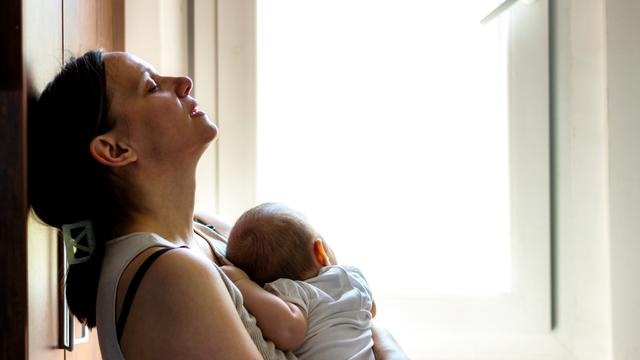Experts speculate that 2022 could be the year moms finally share the mental load… but will it actually happen?
The COVID pandemic has made the very private issue of the division of domestic labor – the way household chores and child care are divided – a very public issue.
During the closures, the burden of housework and childcare increased dramatically for men and women in opposite-sex and same-sex couples in Australia and elsewhere.
Overnight, homes became makeshift offices, daycares and schools and it was mothers who largely took on these teaching and caring roles to the detriment of their anxiety levels and sleep.
While the pandemic has exacerbated the physical demands of care – housework and childcare – it has also exacerbated another part of the work that keeps households and families running: the mental load.
Want to join the family? Sign up to our Kidspot newsletter for more stories like this

We have taken a lot in recent years. Source: iStock
RELATED: “The Key to Mental Load is Communication”
What is the mental load?
Much has been written about mental load over the past two years, with many confusing mental load with housework – cleaning and cooking or looking after children – or planning childcare duties. But the mental load is so much more.
In our recently published research, we define mental load as the combination of two types of work or work: cognitive work and emotional work.
The cognitive aspect of mental load involves the Planning, Planning, and organization necessary to support the proper functioning of families. This type of work ranges from organizing a game date to planning a dinner party.
We argue that this cognitive work becomes a load or mental load when it has an emotional element, for example, when there is worry or stress associated with these tasks.
Some have described listing building as a mental load, but listing building isn’t always stressful or emotional, and most importantly, listing building has a limited beginning and end.
But, once cognitive tasks like making lists take on an emotional element – like worrying about whether Nana will like her gift, the anxiety about how parents will get along at holiday dinners, and the stress of filling in the stockings while finishing the job – then that becomes the mental load.
RELATED: The Truth Is … Motherhood Is Hard

Building lists isn’t always stressful or emotional. Source: iStock
RELATED: Study Confirms Men Do Weight at Home
How does the mental load work?
We argue that the mental load operates in families and societies in three ways.
First it is invisible – this is the type of work that is done internally. Unlike household chores or babysitting, they are invisible and therefore difficult to recognize.
Second, the mental load is without border. Because it is invisible, it can be performed anywhere or anytime.
American sociologist Arlie Hochschild called women’s domestic work done after work a ‘second shift’, but mental load doesn’t have shifts – it can be done before, during and after work or even during the time that should be spent sleeping.
And finally, the mental load is durable, which means it never ends. Unlike household chores like cooking or cleaning, thinking and caring for family members never stops which is why the mental load can be so heavy and Nana always reminds you to take a jacket.
How to reduce mental burdens in 2022 and beyond?
There are a number of things that individuals and society can do to reduce the mental strain.
1) Make the mental load more visible by quantifying it
We do not have a robust, standardized and nationally representative measure of mental workload. This means that unlike housework and childcare, we have no idea how much and what the mental burden is on Australians.
Recent reports on housework show that women do 21 more hours of unpaid work than men. They may also spend most of the day thinking, planning, and worrying about their families.
Yet we have no measure of this work and, more importantly, we also do not know how men handle the mental load.
Quantifying and capturing how much time we spend on the mental load and how it is shared between couples will help lay the groundwork for change.
2) Recognize the tribute of women
The pandemic has left workers exhausted, stressed and overwhelmed by the intensity of balancing work, home schooling and demands for full-time care while being isolated at home.
It’s no wonder the pandemic has put mothers out of work.
Mothers are exhausted not only by the physical demands of work and family, but also by the cognitive work of holding everything together at work while fearing to torpedo the educational future of children by keeping them at home, alone and bonded. to screens.
Mental load, as a relentless internal tormentor, is a drain on well-being with serious consequences for economic productivity and fatigue.
Mental load is a national health emergency and should be treated seriously by workplaces and governments.

Mothers are exhausted. Complete stop. Source: iStock
3) Help families to better reconcile work and family demands
Organizations and governments need to do a better job of helping families combine work and family responsibilities. Mental load overloads women (and some men) especially at work when they think about and worry about the needs of their children.
Workplaces need to improve support for families to reduce the mental burden. This can mean more remote work or concrete programs to support the mental load of workers. It is also likely to improve the productivity of workers.
At the same time, governments need to provide better care infrastructure to support families, for example more universal and affordable child care, supports for children’s transition to and from school, and better care. to the elderly. This will reduce workers’ worries about the experiences of their loved ones while in paid work.
Ultimately, mental burden is a mental health issue and businesses and governments should treat it as such. This will relieve families, and mothers in particular, of the mental burden alone.
Leah Ruppanner is Associate Professor in Sociology and Co-Director of the Policy Lab. Brendan Churchill is an ARC researcher and senior lecturer in sociology. Liz Dean is a lecturer in the sociology program, all at the University of Melbourne.
This article is republished from The Conversation under a Creative Commons license. Read the original article.
